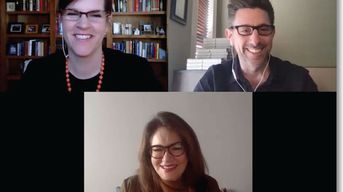Emotions & Relationships During COVID-19 Q&A

In our recent webinar on managing healthy relationships during the COVID era, the participants fielded more questions than we could answer in the hour we had together. So, we’ve answered the most commonly asked questions here.
Q: I seem to be encountering a lot of people in my life who have been changed by this traumatic experience and aren't dealing well with change. How can I adjust to the realities of work now and prepare for “post COVID,” when the worst of the pandemic has passed?
A: Yes, no doubt many of us have found the pandemic to be troublesome if not traumatic. Many people will come back to work “post COVID” silently carrying burdens that they will never share with you. In the workplace, often the only signal we have about someone’s emotional state is their behavior. If a normally cheerful person becomes quiet and pessimistic, we start making assumptions and judgments about their behavior. Marc Brackett challenges us to be emotion scientists rather than emotion judges. As an emotion scientist, we approach emotions – our own and others – with curiosity, creating the possibility to ask questions, have open conversations and improve the quality of our relationships. We can all get better at asking simple questions, like “How are you managing?” and really listening to the answers. We’re all dealing with an enormous amount of change and the more compassionately we can treat each other through this, the better our work environments will become.
Q: How do we understand setting boundaries around feelings if everyone has permission to feel?
A: Emotional intelligence skill actually helps us to create healthy boundaries. Giving myself and others "permission to feel" means that I hold myself responsible for my own emotional reality and also means that other people are responsible for their emotions. One recent learner in our Emotion Life Lab put it this way: “Not everyone has learned how to recognize and regulate their emotions the way I have. There are times in meetings when things get heated, but I know how to stay calm. And when I stay calm, others calm down too. Sometimes I feel like the only adult in the room, but in using my emotional intelligence skills, I do a better job of maintaining positive relationships and moving work forward.”
Q: For those who lead others, how would you recommend we use these great tools?
A: We benefit first by leveraging the tools for ourselves. By building skill in recognizing and regulating emotions for ourselves, we become more responsive as leaders. In practice, it starts by checking in with yourself several times a day, using this structure:
- Right now, I feel: _______
- Feeling this way is helpful to what I'm doing: yes/no
- If the answer is no, answer this: I would like to feel ______ instead.
- To get to the desired emotion, I can [insert a strategy here].
You need to regulate your own emotions before you can co-regulate emotions with other people. In our training, we use this example to demonstrate how a regulated parent can help shift a child to a more helpful emotional state. As emotionally regulated leaders, we have the power to help people shift from anxious to calm, from disappointed to motivated, from frustrated to focused. It only happens, though, when we’ve taken the time to use strategies to shift ourselves first.
Q: Isn’t being your “best self” just another task you’ve got to complete? I’d be happy with “better” self right now :)
A: The vision of a Best Self is a thinking strategy we can use to shift from one emotional state to another. So, instead of thinking of it as a task, I think of it as a way to focus on a larger goal before reacting in an unhelpful way. For example, let’s say I receive an email from a colleague that makes me really angry. If I react in that moment, I might send a nasty response (or at least a passive-aggressive version of a nasty response), potentially increasing the negative feelings between the sender and myself. Imagine instead: I read the email, pause, and consciously note how it makes me feel. “Wow, I am so angry right now. Actually, I guess I’m not angry but more frustrated; I feel like he is creating an obstacle to our progress.” Now I have the capacity to ask: “If the best version of myself were to respond to this email, what would she say? What would be the goal of her response?” Marc likes to say that bringing forth a vision of our Best Self ‘redirects our attention away from the trigger and toward our values.’ With that in mind, I respond to the email in a way that is aligned with my larger objectives and ultimately more helpful to both my work relationships and ability to make progress on my project.
Q: I think a lot of individuals struggle with pushing away or hiding "negative emotions." How is focusing on my "best self" different than this?
A: Acknowledging the unpleasant emotions you are experiencing is an essential part of the best self process. It’s hard to shift to a different emotional state if you don’t actually know the one you are in. When something happens that triggers you into the red quadrant, leveraging a vision of your Best Self look like this:
- Pause and take a breath
- Name the emotion you’re experiencing
- Visualize your Best Self
- Choose a regulation strategy that can help to embody that vision
- Start regulating to make the emotional shift
Marc and Robin call this a Meta-Moment, and as Marc says in his book, “The Meta-Moment involves hitting the brakes and stepping out of time. We call it ‘meta’ because it’s a moment about a moment.” Taking this moment allows you to pause before you say or do something you might regret and instead act in a way that improves a relationship or allows for a better outcome.
Q: Is there a "curriculum" to best move through learning more about EI?
A: If you think about it, it’s pretty obvious that simply reading about the skills or watching a webinar isn’t enough to help you change your behavior for the better. To really learn the skills of emotional intelligence, you have to practice them and receive feedback on your progress. Our Emotion Life Lab program translates Marc’s and Robin’s research into a digital program that builds skills over time. It’s self-paced and includes live coaching, all from the convenience of your smart phone. Go here for more details, including a discount.
Q: How do you help someone move through a feeling rather than getting stuck in them?
A: We often say that we “name it to tame it.” So, it can be quite helpful to simply ask, “How are you feeling?” The very act of labeling the emotion they’re experiencing will help them move past it. There are studies that have shown that emotions such as anxiety or fear are reduced when a person stops to recognize and label those feelings. Building skill in your ability to recognize an emotion as you experience it is essential to learning how to shift away from unhelpful emotions when needed.
Q: How can I interest others in this work? I have family members and work colleagues who could also really use these skills.
A: I’ve found that the best way to interest others (whether they be adults or children) is to lead by example. The more I use my recognition and regulation skills, the more I invite others to do the same. If I’m not willing to invest in developing the skills for myself, it’s a much harder sell to ask those around me to make it a priority. When others observe me staying calm in a situation that previously would have triggered me into the red quadrant, they take notice. By practicing the skills for myself and with others, I create an environment where I give others “permission to feel”, too.
Q: Will the recording of this webinar be accessible to the general public?
A: Yes! You can find recordings of all our webinars here: go.ojilifelab.com/corona-care. These webinars are part of our Corona Care Toolkit, designed to help us navigate the emotional landscape of the pandemic - please take advantage of as many resources as you need.
Latest Posts
BACK TO HOME ❯ Developing New Managers? How to Set Them Up for Success
Developing New Managers? How to Set Them Up for Success
 First-time Managers Are Holding Back Employees & Performance
First-time Managers Are Holding Back Employees & Performance
 Why New Managers Fail and How Oji Foundations is Revitalizing Leadership Training
Why New Managers Fail and How Oji Foundations is Revitalizing Leadership Training
Sign up for our People-Powered Newsletter.
